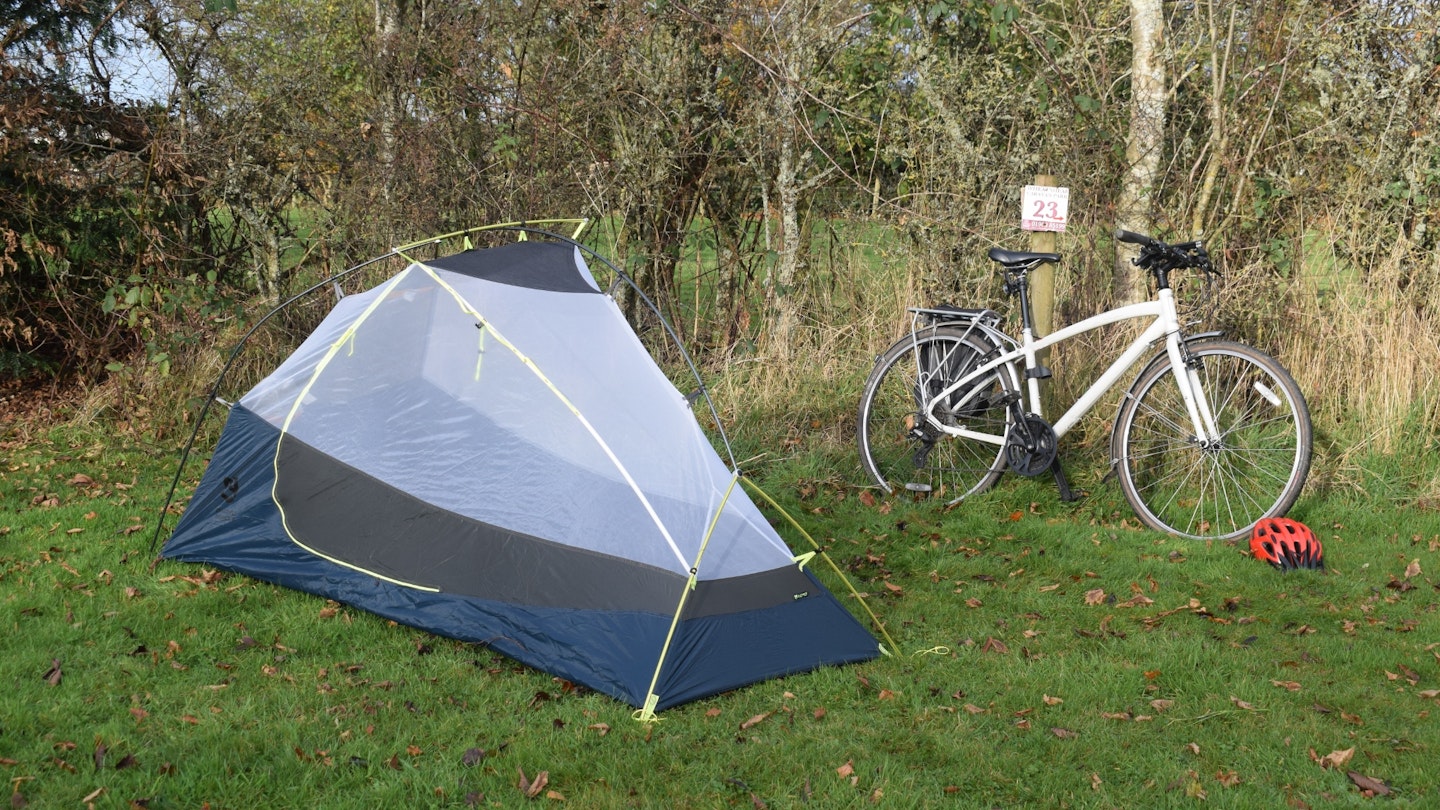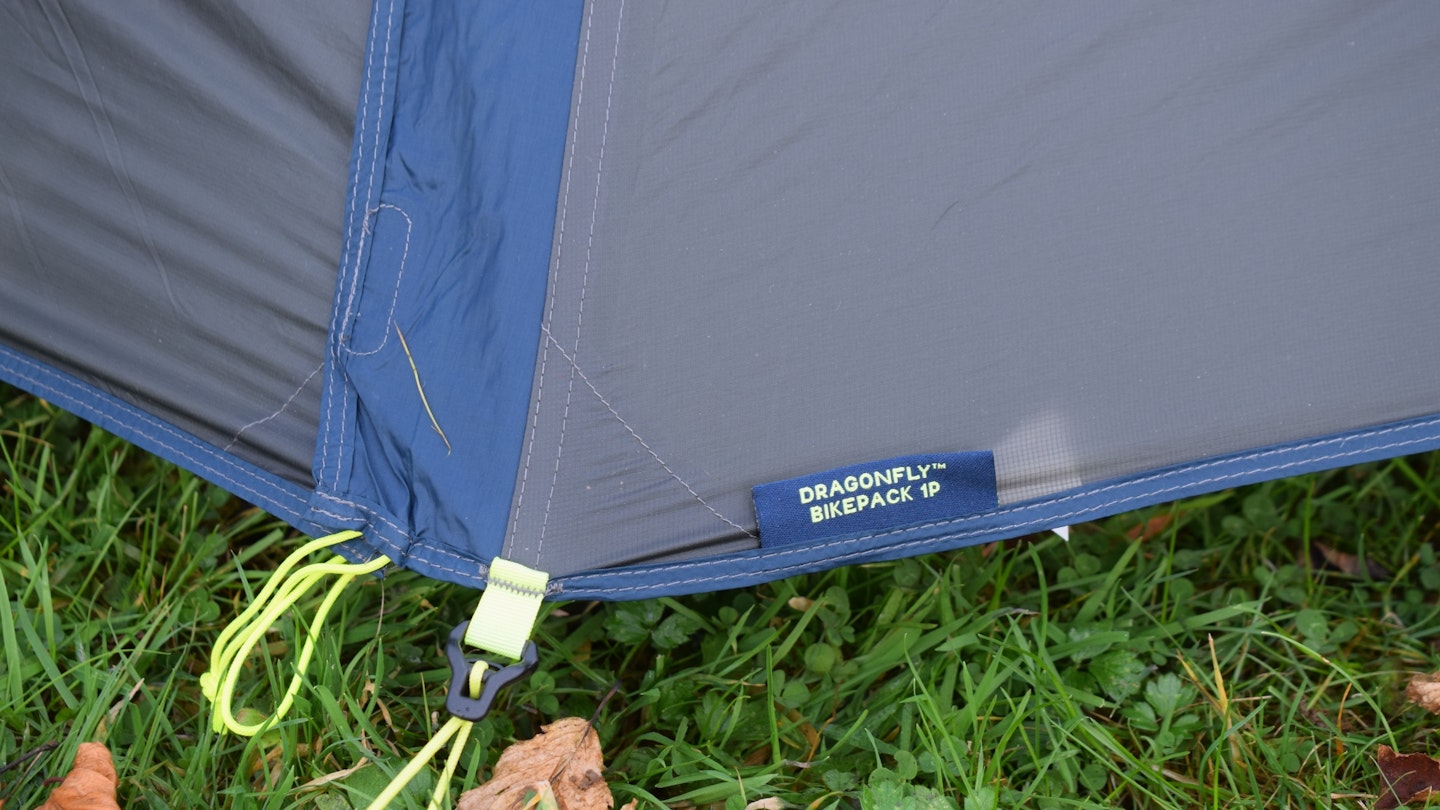There are four bikepacking tents on the market with very similar designs: the MSR Hubba Hubba Bikepack, Sea to Summit Alto TR1 Bikepack, Big Agnes Fly Creek HV UL1 Bikepack Solution Dye and this tent – the Nemo Dragonfly Bikepack Osmo. There is precious little to choose between them.
They all use a near-identical dome-shaped design: an all-in-one, hub-connected pole with Y-shaped wishbone orientation and a wide cross pole in the middle, onto which the inner is pegged before throwing over the flysheet.
This approach gives the tents steep and taut architecture, with excellent headroom, vertical walls and wide floorplans – and thus a superior sense of internal comfort and liveability. It’s a proven approach for camping comfort that works very, very well.
Pros
- Excellent eco credentials
- Superb Osmo fabric
- Comfortable and first-rate internal livability
- Premium design and materials
- Vestibule footprint included
- Effective on-bike stowage
Cons
- Expensive
- Disappointing hydrostatic head ratings
- Mesh inner is draughty
- Not the best in strong winds
- Not ultralight
| RRP | £519.99 / $662.90 |
| Internal peak height: | 102cm |
| Packed size: | 36x13cm |
| Weight: | 1,381g / 3lb 1oz (including carry bag) |
| Internal dimensions (LxW): | 223x90cm |
These tents always clock in at a low(ish) weight and pack away compactly, and – as premium products – come with top-tier materials, features and design innovations.
But there are obvious drawbacks, too. The hydrostatic head ratings are often far lower than the best backpacking and wild camping tents.
Plus, the mesh inners can be cold and draughty, inner-first pitching is inconvenient in the rain, the price-tags are lofty and the steeply-walled architecture is poor in terms of wind-resistance.
The Nemo Dragonfly Bikepack Osmo fits this narrative to a tee. It’s lightweight, super-comfy and very well designed. The structure is wonderfully taut and internally you get loads of space and impressive headroom.
The space-to-weight ratio is top-tier and it’s probably one of my favourite one-person bikepacking-specific tents I've ever tested. But, having said that, it’s not perfect and there are drawbacks, particularly the big cut-out in the flysheet.
Is it the bikepacking tent for you? If you can afford it, it’s certainly an excellent choice – here’s the full lowdown.
Bikepacking features and on-bike stowage

Nemo says the Dragonfly Bikepack Osmo tent is “tailored specifically for two-wheeled journeys... where its ultra-small pack-down size will make a huge difference”.
As with most bikepacking-specific tents, the Dragonfly has been designed with shortened pole segments (31cm long) so that the tent can be folded down more compactly.
The whole tent stows easily into the provided stuff sack, which by my measurements is sized 36x13cm – a wonderfully compact package. This size works very well for on-bike stowage.
The stuff sack – which feels sturdy and has a rolltop closure system – has been optimised for bike travel. It comes with tie-down straps to help eliminate wobble, and the adjustable straps can be securely fastened to handlebars, the rack or the frame.
It’s an effective tent-carrying solution. Nemo says the “highly versatile and rugged roll-top dry bag can be mounted in many locations on your bike”. I'd agree.

It’s annoying, however, that these relatively minor bikepacking upgrades come at such a price premium. This seems to be common across the industry, with bikepacking-specific tents priced far more expensively than their equivalent backpacking versions.
This is true for the Nemo. The Dragonfly Bikepack version sets you back £520, whereas the Dragonfly Osmo Backpacking version is just £420. It still packs away compactly (40x17cm according to Nemo), but you don’t get a bikepacking-specific carry bag.
Ultimately this means you’re paying £100 for smaller poles and a stuff sack. Is that good value? Some bikepackers may prefer to opt for a generic Nemo tent and then stash it in their existing bikepacking bags, rather than buying the pricy bikepacking tent.
Indeed, if you opted for the excellent Nemo Hornet Osmo Ultralight Backpacking tent, it’d only cost you £400 – a saving of £120, and it only weighs 1,020g, too.
Shape, structure, pitching and internal liveability

This tent performs excellently across these metrics. Internal liveability is impressive, the living and sleeping space is comfy and roomy, and all-round comfort levels are great. You get good elbow, shoulder and head room, decent width, near-vertical walls and steep all-round architecture, which is exactly what you need for a sense of internal spaciousness.
The groundsheet tapers slightly by about 9cm towards the foot end (a rectangular shape would be better). Nemo says this approach helps to “save weight without sacrificing liveable space”. That’s slightly wrong – of course you do lose space, 9cm of it, but it’s not massively noticeable, so I see what they mean.
You also get a decent-sized vestibule, so if you need to spread out into the porch, that’s an option too. And the fact you get a footprint for the porch makes this far more palatable in wet conditions, too.
Pitching the tent is simple and quick, using an inner-first approach. First, peg out the four corners of the inner and assemble the hub-connected pole (it has a wishbone “Y” at each end, one larger, one smaller, as well as cross pole in the middle).
Then clip the four colour-coded pole tips into the Jake’s Foot eyelets in the inner’s four corners, suspend the inner to the hub-connected pole structure using clips, position the flysheet over the inner, and peg out the flysheet.
Once pitched, the hub-connected pole structure creates a dome-like shape. The larger wishbone “Y” creates a higher hooped arch at the head end, while the cross pole helps to extend and widen the roof and creates vertical walls.
At the foot end, the wishbone “Y” creates a smaller triangular wedge of height. It’s a proven design and works well. The poles are DAC Featherlite NSL poles made from aluminium. They feel strong yet lightweight and are of a premium quality.
Waterproofing, wind resistance and breathability

The real story of the Dragonfly Bikepack Osmo tent, in terms of weatherproofing, is its innovative Osmo fabric. This is a Nemo innovation.
The brand says it’s a “high-performance, high-strength, poly-nylon ripstop fabric... which has four times better water repellence, three times less stretch when wet and 20% increased tear strength”.
I can’t really scientifically analyse these claims, but what I can say is this: during my test camps on a Lake District campsite in measly weather, the Osmo fabric proved wonderfully taut and tight, with a high-tensioned structure and zero sagging.
It was very easy to pitch and held its shape well. The flysheet shed rain impressively, with droplets forming and running off the structure well, and all-round weather protection seemed pretty solid. I was quite impressed, at least in terms of a first look.
Weatherproof features I particularly liked included the bathtub-style groundsheet, the single-seam construction (with taped seams) and the excellent “landing zone” storage tub footprint (with bathtub style 'lip' of protection) for the vestibule, providing a waterproof zone for gear storage.
However, there are still a few concerns in terms of this tent’s suitability for truly atrocious weather. Firstly, the hydrostatic head ratings are a little underwhelming, particularly considering the lofty price-tag.
The groundsheet has a 1,200mm rating while the flysheet is 1,500mm rated. These ratings are okay, but not great – and for added reassurance, I'd have hoped for higher figures.
Having said this, I was impressed with the Osmo fabric – and, perhaps, time will tell that this tent’s waterproofing comes more from the fabric’s high-tech design, rather than the raw hydrostatic head stats.
A bigger worry is the way large sections of fabric are cut-out of the flysheet to save weight. At the head and foot end there are asymmetrical cut-outs in the flysheet fabric, which expose the inner’s bathtub-style sheet and could prove a weak spot in awful conditions.
On top of this, the flysheet doesn’t peg out flush to the ground and leaves a big gap underneath it – another potential vulnerability to water ingress, particularly in horizontal rain.
The positive side of the flysheet shape is breathability. This tent feels very airy, with good airflow, and it feels well-equipped for avoiding condensation.
Of course, this does mean the mesh inner can feel cold and draughty at times, but hopefully if you’re cosily cocooned in a warm down sleeping bag, this shouldn’t really matter.
Wind protection is okay, but not great. With all the guylines and cords pegged out, the tent feels pretty stable and secure. However the steep-walled architecture is quite high, which always means there’s a risk the tent can catch the wind. It certainly isn’t the most low-profile, wind-streamlined tent shape I've ever seen.
Weight and packed size

The Nemo Dragonfly Bikepack Osmo mostly hits the mark when it comes to weight and packed size. It’s lightweight at 1,381g (including carry bag) and it packs away very compactly into a well-designed carry bag with rolltop closure, sized 36x13cm. Across both metrics it works well for bikepacking.
However, for £520, I'd have preferred a lower weight. Yes, 1,381g is decent but not exceptional, and in my eyes it doesn’t classify as ultralight.
Indeed, the Nemo is slightly heavier than both the Big Agnes Fly Creek HV UL1 Bikepack Solution Dye (1,110g) and the Decathlon Forclaz Trekking Dome Tent MT900 (1,302g).
On my scales, the Dragonfly’s weight is broken down as follows: flysheet and inner (697g), hub-connected poles including pole repair splint (394g), pole bag (13g), 11 tri-angled pegs with cord pull-loops and tent repair patches (181g), peg bag (15g) and main carry bag (81g).
Features and sustainability

This tent has some clever and thoughtful features. I particularly liked the overhead roof mesh pocket, which made gear organisation and storage particularly convenient, while the daisy-chain loops on the inner’s roof helped with drying out wet kit. There’s also an overhead nightlight pocket – simply stash your headtorch inside it and it’ll transform it into a ceiling-mounted lamp.
All of Nemo’s product come with a lifetime warranty, which adds a touch of reassurance to a big investment. Although, of course, this only covers manufacturing faults and not general wear and tear, or any avoidable accidents such as rips from very strong winds.
The small print states: “All Nemo products carry a limited lifetime warranty against defects in workmanship and materials to the original owner, with proof of purchase from an authorized Nemo dealer”.
The eco credentials of this tent are much stronger than many others. The flysheet’s Osmo fabric is made from 100% recycled yarns that are PFAS-free and meet flame-retardant standards without the use of added chemicals.
The flysheet and groundsheet are bluesign-approved materials that “meet strict ecological and chemical requirements and have been produced with a minimum impact on people and the planet”, according to Nemo.
One other thing to note is that the Dragonfly uses subdued colours and non-reflective materials, so the tent works well for stealth and wild camping.
Verdict
The Nemo Dragonfly Bikepack Osmo is a spacious, comfy, well-designed dome-style tent with a superb flysheet fabric. But, it’s pricy and the flysheet cut-outs aren’t ideal for the UK’s wet climate. Still, it can rival other top-tier bikepacking tents like the questionably named MSR Hubba Hubba.
Shop this product
About the author

James Forest writes regular features and route guides for Trail and has been one of our main gear testers for the last few years. James is based on the edge of the Lake District so when he isn’t off on his latest crazy adventure or challenge, he’s walking in his local fells.










